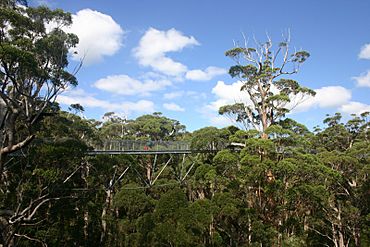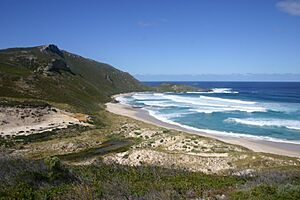Walpole-Nornalup National Park facts for kids
Quick facts for kids Walpole-Nornalup National ParkWestern Australia |
|
|---|---|
|
IUCN Category II (National Park)
|
|

The Tree Top Walk in the Valley of the Giants
|
|
| Nearest town or city | Walpole |
| Established | 1957 |
| Area | 194.48 km2 (75.1 sq mi) |
| Managing authorities | Department of Environment and Conservation |
| Website | Walpole-Nornalup National Park |
| See also | List of protected areas of Western Australia |
The Walpole-Nornalup National Park is a special natural area in the South West region of Western Australia. It's about 355 kilometers (220 miles) south of Perth. This park is famous for its super tall karri and tingle trees. Some of these trees, like the red tingle, only grow in the Walpole area!
The park is also part of a bigger natural area called the Walpole Wilderness Area. This area was created in 2004 and is known as an international "biodiversity hotspot." This means it has many different kinds of plants and animals that are very important to protect.
Discovering the Park's Past
Who Lived Here First?
The land where Walpole-Nornalup National Park now stands has a very long history. The first people to live here were the Murrum people, who are part of the Minang group. They are also part of the larger Noongar people. These traditional owners have lived in this region for over 30,000 years!
How the Park Got Its Name
The park is named after the nearby town of Walpole. The town was named to honor William Walpole. He was a naval officer who served with James Stirling on a ship called HMS Warspite way back in 1809.
The Noongar people have their own name for the area: Nor-Nor-Nup. This name means "the place of the black snake." Later, this name was changed slightly to "Nornalup" by European settlers.
Early Explorers and Settlers
In 1841, an explorer named William Nairne Clark visited this area. He even sailed up the Frankland River. Later, in 1877, a botanist (someone who studies plants) and explorer named Ferdinand von Mueller also explored the region.
The first European family to settle here was the Bellanger family. They arrived in 1910 and built their home near the Frankland River in 1914.
Becoming a National Park
The idea for the park started in 1910. James Mitchell, who was in charge of Lands and Agriculture at the time, visited the area. He was so amazed by its beauty that he decided to protect it. He set aside about 370 hectares (about 914 acres) of land for conservation. This was called an "A-class reserve," meaning it was a very important area to protect.
Later, in 1912, another piece of land west of the Irwin Inlet was also made a reserve. This area was eventually added to the national park.
Fun Things to Do in the Park
Walking Among Giants
One of the most popular places to visit in the park is the Valley of the Giants. It's a truly amazing spot!
The Tree Top Walk
If you're not afraid of heights, you can try the Tree Top Walk. This special walkway is about 40 meters (131 feet) high! It lets you walk right through the tops of the giant tingle trees. It's even designed so people using wheelchairs can enjoy it.
Many other tree canopy walks around the world are like suspension bridges, which can swing and feel a bit wobbly. But the Tree Top Walk is different! It's made of strong, lightweight steel sections built on steel poles. This makes it a very safe and steady ramp to walk on.
The Ancient Empire
Below the Tree Top Walk, there's another path called the "Ancient Empire." This path winds around the huge tingle trees on the ground. It's a great way to see these ancient giants up close.
Spotting Whales and Dolphins
At Conspicuous Beach, there's a great spot to watch for whales. You might see humpback and southern right whales as they migrate past the coast. You can also often spot playful dolphins swimming in the ocean.
Nature and Wildlife in the Park
Amazing Tingle Trees and Bushfires
The tingle trees in the park are very special. They have learned to survive bushfires! They can handle smaller fires because they grow from just under their outer bark. Even if the inside of a tingle tree looks completely burned, it can still be alive and growing.
To help protect the park, the Department of Parks and Wildlife sometimes does controlled burns. This means they carefully set small fires to reduce the amount of dry leaves and branches on the ground. This helps prevent much larger, more dangerous bushfires from starting.
Diverse Habitats
The park isn't just about forests! It also stretches all the way to the coast. This means it has many different types of environments, called habitats. You can find thick forests, coastal heathland (areas with small shrubs), and even swampy areas with paperbark trees. There's also a special red flowering gum tree that only grows in this region.
Conspicuous Cliff is one of the few places where you can easily reach the coast within the national park. The park also includes the Walpole-Nornalup Inlets, which are fed by the Deep and Frankland rivers.
Hiking the Bibbulmun Track
The famous Bibbulmun Track, a long walking trail, goes right through the park and out to the coast. It's a great way to explore the park's beautiful scenery on foot.
 In Spanish: Parque nacional Walpole-Nornalup para niños
In Spanish: Parque nacional Walpole-Nornalup para niños



